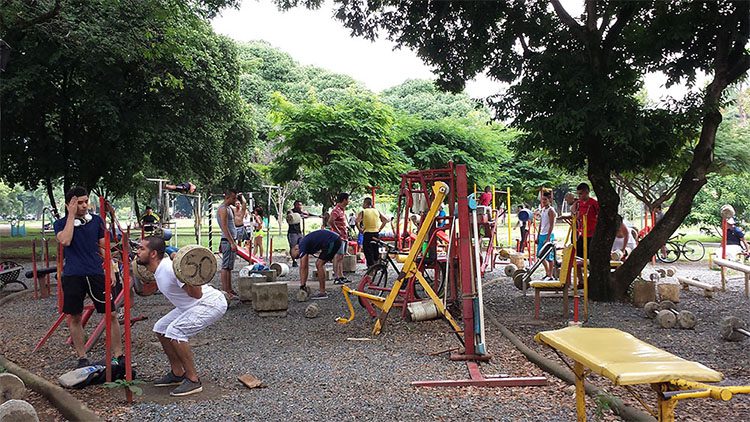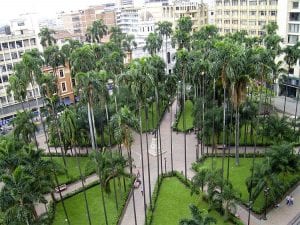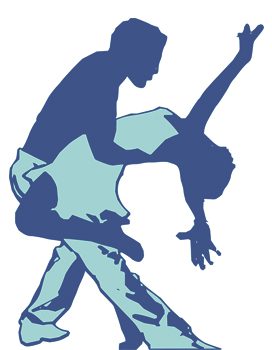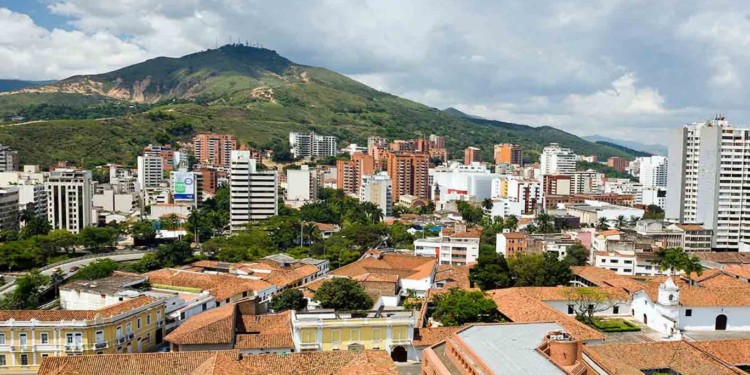My workout over, I wipe my brow and walk over to chat with Sergio.
Sergio comes to Parque El Ingenio almost every day to sell agua de panela—water flavored with brown cane sugar and lime—to the folks who exercise at what I have come to call “The Flintstones Gym.” The equipment here is homemade. Barbells and dumbbells sport blocks of concrete rather than steel plates, but the equipment is well maintained, and this is a popular spot in the mornings. The men who come here are serious about working out but also friendly, and they welcome me with smiles and nods.
Sergio pours me a generous cup of agua de panela, and I fish a sweaty 1,000-peso bill—about 35 cents—from my pocket. I hand it over and we begin another of our curious conversations, me speaking in basic Spanish, Sergio in fractured English. I’m not sure if we do this to be polite to one another or simply to practice each other’s language, but it’s become our established manner of chatting each morning.
Sergio, like most Colombians, is friendly, open, and curious about the United States. I’ve found the Caleños, as Cali residents refer to themselves, to be particularly so. The weather here in Cali is warmer than in Medellín, and, in my opinion, so are the people.
I survey the activity all around us as we chat. The park is bustling, and it’s only just after 8 a.m.
About 30 guys or so are grunting away at the Flintstones Gym. Twenty yards over, most of the interval-training machines are in use. Past the machines, the morning dance-aerobics class is in full swing with 60 or 70 enthusiasts clapping and sweating to the strains of salsa and cumbia. A young Arnold Schwarzenegger is flipping a tractor tire over and over again while, nearby, two teens practice judo throws.
A jogging path encircles this handsomely manicured park where open, grassy areas intermingle with shade trees. All the activities here are provided free of charge by the city and volunteers.

I smile. It’s hard not to. This city has turned out to be my favorite stop in my tour of Colombia.
Cali, in the Valle del Cauca, south of Medellín, is Colombia’s third largest city, with around 2.5 million inhabitants. It sprawls across a plain east of the Farallones de Cali cordillera, which runs roughly north to south an hour inland from the Pacific coastline.
Cali is located near the equator but at an altitude of almost 3,300 feet, so its climate is agreeable and changes little throughout the year. Afternoons can be hot, but with the approach of sunset a refreshing breeze sweeps through the city. Early mornings are deliciously crisp and perfect for brisk walks.
In Cali, urban development and nature effortlessly intertwine. During my time in the city, I stayed on the affluent south side, just a couple of blocks from Calle 13, a major north-south thoroughfare, yet each night I fell asleep to the gentle chirping of tiny frogs and awoke each morning to birdsong. Hummingbirds visited to snatch bits of banana from the tray outside the picture window before darting away again. Enormous shade trees, thoughtfully left by the developer, provided relief during the heat of the day.
Perhaps inevitably, Cali is constantly compared with Medellín, Colombia’s second largest city. Medellín has a lot going for it. It is clean, safe, and modern and offers many cultural activities. The locals tout its climate as “perpetual spring.”
Though I enjoy Medellín, it falls short in one important aspect: green spaces. Sure, there are gorgeous areas nearby, but, within the city proper, growth has eaten up most of the free space until only a few small parks remain. I love greenery, and at times Medellín felt a bit sterile to me.

Cali, by contrast, has done a wonderful job of preserving its trees. Towering palms run down the middle of wide boulevards. Shade trees drape themselves over the narrower streets. Everywhere, you encounter parks, paths, and green spaces—especially on the south side.
Jogging trails continue from Parque El Ingenio across Calle 13. Abutting the park to the south is the sprawling campus of the Universidad del Valle. A few minutes farther south lies the Humedal del Río Pance, a captivating park that’s home to a variety of fowl and small mammals. Assorted paths and smaller greenways crisscross the area.
I’ve lived in Atlanta, Georgia, and in Charlotte, North Carolina. People often remark how green those cities are. They are—but they can’t hold a candle to Cali. My time in Cali, with the greenery and the health-conscious culture, was restorative.
Cali’s charms extend to its people. Most Caleños are polite and friendly. Several times a day, people I had never met before would bid me good morning or good afternoon. I found it easy to strike up a conversation. I grew up in the American South, where the little pleasantries of everyday life form an important part of the culture. It’s nice to know those values haven’t disappeared in the rest of the world.
You won’t find a large expat community in Cali, but many people speak some English, and those who do make an effort to use it. I was also surprised by the number of locals I met with ties to the United States. Many have family there, and many more have spent extended stays. I never once felt that, as a gringo, I was unwelcome. Quite the contrary.
While Cali can’t rival Bogotá or Medellín for cultural activities, it boasts a quality zoo, a small gold museum, a butterfly center, an anthropology museum at the University del Valle, and a replica of Rio’s Christ the Redeemer overlooking the city, among other sights. There are many pleasant places to visit nearby, as well, such as the colonial town of Popayán.
 Cali is also acknowledged as the world capital of salsa. If you can swing dance, salsa is easy enough to pick up, should you feel the urge. Just loosen up your hips and lace up your boogie shoes.But for me, Cali’s real draws are its understated beauty, health-conscious lifestyle, and the Caleños themselves.
Cali is also acknowledged as the world capital of salsa. If you can swing dance, salsa is easy enough to pick up, should you feel the urge. Just loosen up your hips and lace up your boogie shoes.But for me, Cali’s real draws are its understated beauty, health-conscious lifestyle, and the Caleños themselves.
Oh, and its low cost of living!
Across the board, Cali is cheaper than Medellín, even in the more affluent south side. Housing costs are more than reasonable here, and rental rates in Cali are 25% to 30% less than in Medellín.
Why should Cali be so inexpensive? For one thing, it hasn’t experienced the influx of foreigners that has contributed to price increases in cities such as Medellín and Santa Marta. Also, unlike Medellín, Cali still has room to spread out. And, to be frank, Cali’s reputation for crime has hindered development to some degree.
Cali’s tainted reputation left me a bit confused. I spent almost a month there, visited different parts of town, walked a great deal, and always felt safe. How would I reconcile what I’ve read and what I experienced?
Large cities everywhere have good areas and bad areas. What I’ve seen throughout Latin America, where disparities in wealth continue to be pronounced, is that the rough areas can be quite rough—but the nicer areas quite nice. As a gringo with dollars, you’ll base yourself in one of the better areas. Simply avoid the rough areas. Any local can tell you what parts of town are sketchy.
The barrios around Parque Ingenio and Universidad del Valle are uniformly lovely and safe. These include El Ingenio, Mayapi, Sector Multicentro, Meléndez, Campestre, Pance, and Golf Club.
Just how affordable is affordable in Cali? You could buy a three-bedroom, two-bath apartment of 97 square meters in a great location and a great building for 138 million pesos. Right now, that’s US$45,100.
John Clites
For Overseas Property Alert










